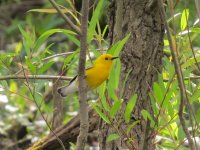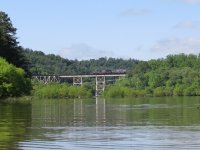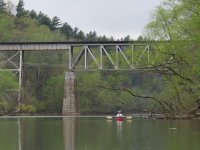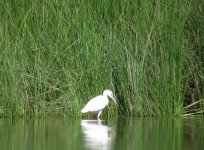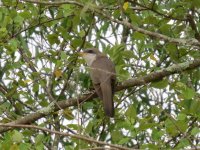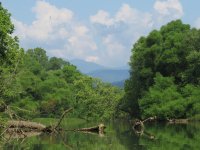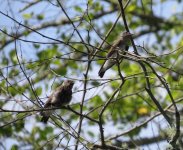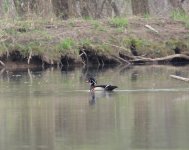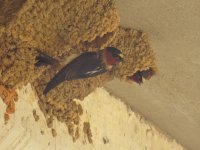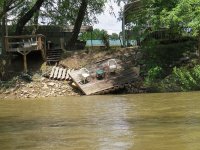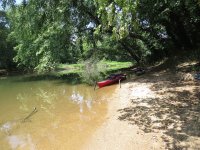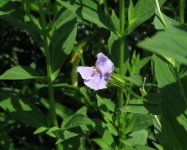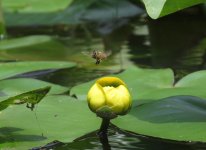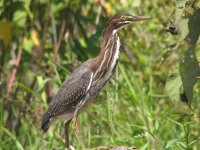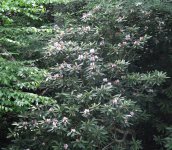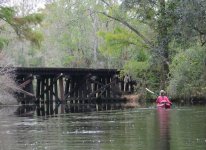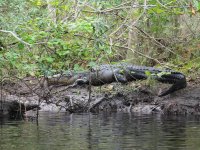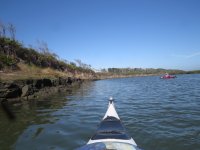Hamhed
Well-known member
Though we never know what month we will have the chance to go, my wife, Liz, and I like to do a once a year kayak trip up the Catawba River at the west end of Lake James in McDowell County, North Carolina. There’s good birding there and our best chance to see a Prothonotary Warbler without leaving the mountains. Okay, we’re at 1200 feet which some wouldn’t qualify as mountains but for more than two thirds of the state, a lofty altitude.
The boat ramp we use is Burnette’s Landing at the end of Hankins Road. At the ramp, a variety of pine trees and deciduous trees along with a wide expanse of shallow water attracts a diverse variety of bird life. In the warmer months when we tend to go, Brown-headed Nuthatches, Pine and Parula Warblers are often heard along with Song Sparrows, Carolina Wrens and Northern Cardinals. On the water, Great Blue Herons and Belted Kingfishers are also common. Studying Swallows is easy since four species - Rough-winged, Barn,Tree and Cliff - and will congregate on the low wires above the wooden dock long since adjusted to the people and boat traffic. This is a link to the 99 species shown in eBird bar charts:
https://ebird.org/barchart?r=L4689371&yr=all&m=
Morning paddling across the last open water of the lake proper is almost never windy so in just a few minutes, we’re cruising by the willows on an island likely formed by silt coming down the Catawba. It has grown in recent years, held in place by willow and buttonbush roots. Our first chance to see or hear the yellow swamp bird we came for is here and we’re not often disappointed.
The railroad trestle is in full view now. As we pass underneath the tall structure, the water narrows down to river size with a current that gradually becomes noticeable but fairly minimal at this point in our travels. Hillsides of rhododendrons and deciduous trees on our left, we regularly hear several species of Vireos here. Red-eyed are the most common, Blue-headed are better heard early as they migrate up to higher elevations, Yellow-throated are there too; we heard three on yesterday’s trip. White-eyed Vireos are usually found further up the river making this a great place to work on Vireo identification as well as the Swallow family.
A low area to our right is also prime habitat for Prothonotarys and they soon become a “trash bird” as we soak up the relaxing experience of rhythmic strokes and constant bird activity. We flush a number of Great Blue Herons and this time an immature Little Blue Heron, so similar to a Snowy Egret, we had to work hard for the correct identification. Yellow-billed Cuckoos sound off with regularity; they’re often seen as well, working the willows along river edge.
The boat ramp we use is Burnette’s Landing at the end of Hankins Road. At the ramp, a variety of pine trees and deciduous trees along with a wide expanse of shallow water attracts a diverse variety of bird life. In the warmer months when we tend to go, Brown-headed Nuthatches, Pine and Parula Warblers are often heard along with Song Sparrows, Carolina Wrens and Northern Cardinals. On the water, Great Blue Herons and Belted Kingfishers are also common. Studying Swallows is easy since four species - Rough-winged, Barn,Tree and Cliff - and will congregate on the low wires above the wooden dock long since adjusted to the people and boat traffic. This is a link to the 99 species shown in eBird bar charts:
https://ebird.org/barchart?r=L4689371&yr=all&m=
Morning paddling across the last open water of the lake proper is almost never windy so in just a few minutes, we’re cruising by the willows on an island likely formed by silt coming down the Catawba. It has grown in recent years, held in place by willow and buttonbush roots. Our first chance to see or hear the yellow swamp bird we came for is here and we’re not often disappointed.
The railroad trestle is in full view now. As we pass underneath the tall structure, the water narrows down to river size with a current that gradually becomes noticeable but fairly minimal at this point in our travels. Hillsides of rhododendrons and deciduous trees on our left, we regularly hear several species of Vireos here. Red-eyed are the most common, Blue-headed are better heard early as they migrate up to higher elevations, Yellow-throated are there too; we heard three on yesterday’s trip. White-eyed Vireos are usually found further up the river making this a great place to work on Vireo identification as well as the Swallow family.
A low area to our right is also prime habitat for Prothonotarys and they soon become a “trash bird” as we soak up the relaxing experience of rhythmic strokes and constant bird activity. We flush a number of Great Blue Herons and this time an immature Little Blue Heron, so similar to a Snowy Egret, we had to work hard for the correct identification. Yellow-billed Cuckoos sound off with regularity; they’re often seen as well, working the willows along river edge.




